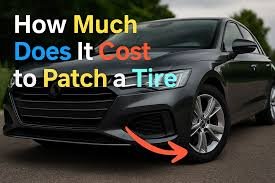1. Introduction: Why This Ma
That’s the question on many drivers’ minds—when a nail, screw, or road debris punctures your tire. While some sources suggest a patch or plug ranges between $10 and $50, others cite averages like $54–64 for more involved repair.
In this guide, I’ll walk you through every variable affecting cost, when to patch vs replace, how this looks in different regions, and how to avoid overpaying or compromising safety. Drawing from real shop experience and industry sources, this article is your one-stop reference for tire patch pricing.
2. Cost Range Overview & What the Benchmarks Say
| Repair Type / Scenario | Typical Cost Range* | Notes / Conditions |
|---|---|---|
| Simple plug in tread | $10 – $25 | Small hole, minimal labor. |
| Patch (inside) | $20 – $50 | More labor (bead off, interior accessz) |
| Combo Patch + Plug | $25 – $60 | Common for more reliable repair in modern shops |
| More complex damage (rim area, bead, multiple holes) | $50 – $100+ | Depends on complexity, risk, materials |
| Replacement instead of repair | $70 – $200+ | If damage too severe (sidewall etc.) |
3. Key Factors That Drive the Cost
3.1 Location & Labor Rate
Labor hours are the biggest cost factor. In high-wage areas or premium shops, labor can dominate the bill.
3.2 Damage Location & Severity
- Tread area punctures: easiest to repair.
- Shoulder / sidewall / bead: much harder or impossible to patch safely.
- Multiple punctures or large holes: may require replacement.
3.3 Materials & Parts
Patches, adhesives, plugs, internal liners, and even cleaning consumables all add up.
3.4 Tire Type & Size
Special tires (run-flat, performance, large rims) may cost more to dismount, inspect, remount, and balance.
3.5 Additional Services
- Rebalancing after repair
- Valve stem replacement
- Taxes / shop markup
- Disposal of tire (if replacing)
3.6 Regional / Geographic Variation
Costs vary country to country, city to city, based on labor costs, parts availability, competition, etc.
4. Patch vs Plug vs Replace — Decision Matrix
Here’s a visual decision guide to help you choose:
4.1 Plug (External)
- Quick, cheap.
- Best for tiny holes in tread.
- But less durable if not combined with patch.
- Many experts (e.g. MotorTrend) caution that plugs alone are less safe long term.
4.2 Patch (Internal)
- More durable, more secure.
- Requires removing tire from rim.
- Ideal for most tread punctures if damage is modest.
4.3 Combo Plug + Patch
- Many modern shops combine both for safety.
- More costly, but gives redundancy.
4.4 Replace
- Required if damage is on the sidewall or too large.
- Use when repair risk > safety margin.
5. Step-by-Step: What Happens During a Professional Patch
At a high-level, here’s what a good repair shop does:
- Remove tire from vehicle
- Inspect interior and exterior
- Mark puncture
- Remove bead / separate tire from rim
- Clean and prep the hole (buffing, scoring)
- Insert patch or plug/patch combo
- Cure adhesive / bond
- Re-mount tire on rim
- Inflate and balance
- Final inspection & leak test
This full process is more time and labor than just a plug, hence the cost difference.
6. Real World Examples & Cost Quote
- A user paid $27.99 for a patch and criticized markup in a forum.
- Some shops plug for $25 and patch for $30 in U.S. areas.
- According to Jerry.ai, patch cost spans $10–50 depending on repair location.
- MotorTrend suggests patch & glue alone may cost ~$30 before labor.

7. Cost Variation by Country / Region
Because you may be reading this from anywhere (e.g. Pakistan, UK, US), here’s how cost can shift:
| Region / Country | Expected Range (local currency) | Key Considerations |
|---|---|---|
| US / Canada | $10 – $60 | Many shops, competition, high labor |
| UK / Europe | £10 – £40 / €10–€50 | Labor slightly lower or higher in some cities |
| Pakistan / South Asia | PKR 500 – PKR 5,000+ | Local labor cost low but imported parts may lift cost |
| Remote / Rural Areas | Slight premium | Travel, fewer shops increases cost |
(These are estimates—always get local quotes.)
8. How to Avoid Being Overcharged & Smart Tips
- Always ask for itemized quote (labor, parts, balancing)
- Compare 2–3 local shops
- Ask whether rebalancing is included
- Check shop reputation / reviews
- Avoid emergency / roadside markup unless necessary
- If damage is minimal and you’re confident, a DIY plug kit (~$5-$15) may suffice as a temporary fix
9. Longevity & Safety Considerations
- A well-executed patch can last many years, possibly as long as the tire’s life under normal use
- Avoid patching more than once in the same area
- Never patch sidewall damage — structural risk
- If vibration or leaking recurs, repair likely failed
- Always have a professional inspect a home repair if possible
10. FAQ & Troubleshooting
Q: Can I patch a tire myself?
A: For small tread punctures, yes (with a plug kit). But you risk improper prep, poor bonding, or missing internal damage.
Q: How long does a repair take?
A: A full patch job usually takes 20–30 minutes (plus tire removal and balancing).
Q: Will rebalancing always be required?
A: Ideally yes, to maintain balance after interior repair.
Q: Can I drive home before repair?
A: Only if the leak is very slow and the damage is small. But it’s best to avoid driving any distance; you risk further damage.
